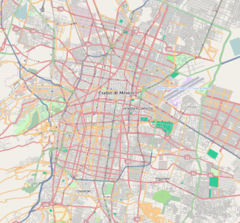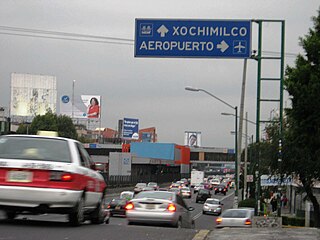
Viaducto is a station on Line 2 of the Mexico City Metro system. It is located in the border of Benito Juárez and Iztacalco boroughs of Mexico City, south of the city centre on Calzada de Tlalpan. It is a surface station.

Tacuba is a station of the Mexico City Metro. It is located in the Tacuba district of the Miguel Hidalgo borough, to the west of downtown Mexico City. It lies along Lines 2 and 7.

Cuitláhuac is a station on the Mexico City Metro. It is located in the Colonia Popotla and Colonia San Álvaro districts in the Miguel Hidalgo borough of Mexico City, to the northwest of the city center. It lies along Line 2. In 2019, the station had an average ridership of 18,615 passengers per day.

Colegio Militar is a station on Line 2 of the Mexico City Metro system. It is located in the Miguel Hidalgo borough of Mexico City, northwest of the city centre, on Calzada México-Tacuba. In 2019 the station had an average ridership of 15,275 passengers per day.
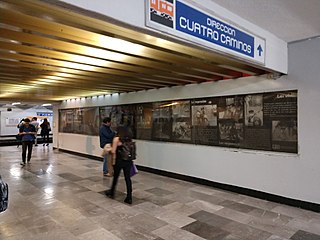
Normal is a station on Line 2 of the Mexico City Metro system. It is located in the Miguel Hidalgo municipality of Mexico City, northwest of the city centre, near the Calzada México-Tacuba. In 2019, the station had an average ridership of 35,260 passengers per day.

San Cosme is a station on Line 2 of the Mexico City Metro system. It is located in the Cuauhtémoc municipality of Mexico City, northwest of the city centre, on Avenue Ribera de San Cosme a few blocks before it becomes Calzada México-Tacuba. The southern exit leads to Colonia San Rafael while the Northern one leads to Colonia Santa María la Ribera. It is two blocks from the Mercado de San Cosme. In 2019, the station had an average ridership of 22,891 passengers per day.
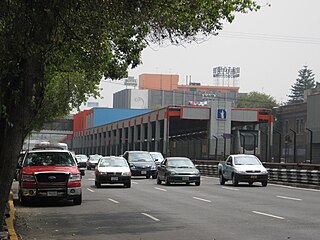
San Antonio Abad is a station on Line 2 of the Mexico City Metro system. It is located in the Colonia Tránsito and Colonia Obrera neighborhoods of the Cuauhtémoc borough of Mexico City, to the south of the city centre, in the median of Calzada San Antonio Abad.
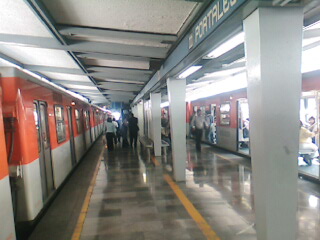
Portales is a station on Line 2 of the Mexico City Metro system. It is located in the Colonia Albert and Colonia Portales neighborhoods of the Benito Juárez borough of Mexico City, directly south of the city centre in the median of Calzada de Tlalpan. It is a surface station.

Ermita is a station on Line 2 and Line 12 of the Mexico City Metro system. According to the Sistema de Transporte Colectivo, Ermita serves as a transfer station of Line 12. It is located in the Benito Juárez borough of Mexico City, directly south of the city centre on Calzada de Tlalpan.

UAM-Azcapotzalco is a metro station in northern Mexico City, located in the Azcapotzalco borough, along Line 6. In 2019, the station had an average ridership of 8,076 passengers per day.
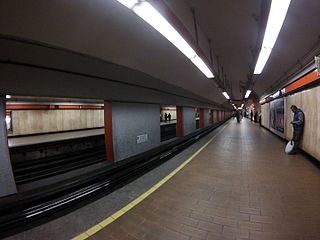
Constituyentes is a station on Line 7 of the Mexico City metro on the western outskirts of the city center. It serves Chapultepec Park and numerous attractions therein, as well as the Luis Barragán House and Studio. The station opened on 23 August 1985.

Atlalilco is a station along Line 8 and Line 12 of the metro of Mexico City. Atlalilco is a transfer station between the Line 12 and Line 8. Line 8 station is located on the Calzada Ermita Iztapalapa, while Line 12 station is located on Avenida Tláhuac, in the Colonia Santa Isabel Industrial neighbourhood.
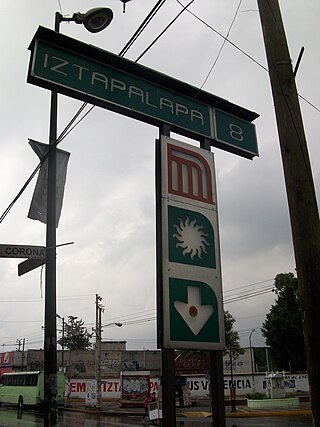
Iztapalapa is a station along Line 8 of the metro of Mexico City. It is located on the Calzada Ermita Iztapalapa in the Colonia El Santuario neighborhood of Iztapalapa borough on the southeast side of the city.

Cerro de la Estrella is an underground station along Line 8 of the metro of Mexico City. The station is located along the Calzada Ermita-Iztapalapa and serves the Colonia Hidalgo y Mina neighborhood within the Iztapalapa borough on the east side of the city. The station is named for the Cerro de la Estrella – a mesoamerican archaeological site located nearby. It was opened on 20 July 1994.
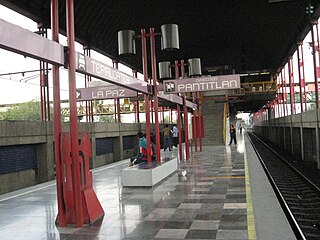
Tepalcates is a station on the Line A of the Mexico City Metro. It is located in the Iztapalapa municipality, to the east of downtown Mexico City. In 2019, the station had an average ridership of 19,326 passengers per day.

Guelatao metro station is a Mexico City Metro station in the Iztapalapa borough of Mexico City. It is an at-grade station that serves Line A between Tepalcates and Peñón Viejo stations.
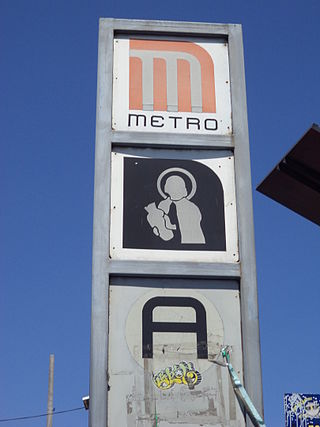
Santa Marta is a station along Line A of the Mexico City Metro. It is located in the Colonia Ermita Zaragoza neighborhood of the Iztapalapa borough in Mexico City.

Line 12, also known as the Golden Line from its color on the system map, is a rapid transit line of the Mexico City Metro network. It travels 25.1 kilometers (15.6 mi) along the boroughs of Benito Juárez, Iztapalapa and Tláhuac in southwestern, central-southern and southeastern Mexico City, serving twenty stations. The line was inaugurated on 30 October 2012, going from Tláhuac to Mixcoac station. In 2016, work to expand it to Observatorio station started. All the stations are accessible to people with disabilities as they have elevators, tactile pavings and braille signage plates.
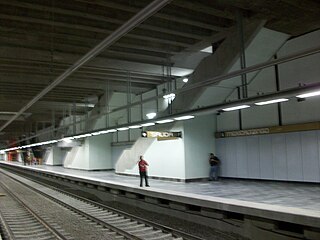
Mexicaltzingo is a station on Line 12 of the Mexico City Metro. The station is located between Ermita and Atlalilco. It was opened on 30 October 2012 as a part of the first stretch of Line 12 between Mixcoac and Tláhuac.

Culhuacán is a station on Line 12 of the Mexico City Metro. The station is located between Atlalilco and San Andrés Tomatlán. It was opened on 30 October 2012 as a part of the first stretch of Line 12 between Mixcoac and Tláhuac.

